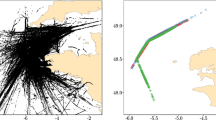Abstract
We present efficient algorithms for segmenting and classifying trajectories based on a movement model parameterised by a single parameter, like the Brownian bridge movement model. Segmentation is the problem of subdividing a trajectory into interior-disjoint parts such that each part is homogeneous in its movement characteristics. We formalise this using the likelihood of the model parameter, and propose a new algorithm for trajectory segmentation based on this. We consider the case where a discrete set of m parameter values is given and present an algorithm to compute an optimal segmentation with respect to an information criterion in O(nm) time for a trajectory with n sampling points. We also present an algorithm that efficiently computes the optimal segmentation if we allow the parameter values to be drawn from a continuous domain. Classification is the problem of assigning trajectories to classes of similar movement characteristics. The set of trajectories might for instance be the subtrajectories resulting from segmenting a trajectory, thus identifying movement phases. We give an algorithm to compute the optimal classification with respect to an information criterion in \(O(m^2 + km\log m)\) time for m parameter values and k trajectories, assuming bitonic likelihood functions. We also show that classification is NP-hard if the parameter values are allowed to vary continuously and present an algorithm that solves the problem in polynomial time under mild assumptions on the input.








Similar content being viewed by others
Notes
For this they introduce a new model for similarity. The term model is used in our paper in a different sense, namely as referring to statistical models.
References
Alewijnse, S.P.A., Buchin, K., Buchin, M., Kölzsch, A., Kruckenberg, H., Westenberg, M.A.: A framework for trajectory segmentation by stable criteria. In: Proceedings of the 22nd International Conference on Advances in Geographic Information Systems (ACM GIS), pp. 351–360. ACM (2014)
Aronov, B., Driemel, A., Kreveld, M.V., Löffler, M., Staals, F.: Segmentation of trajectories on nonmonotone criteria. ACM Trans. Algorithms (TALG) 12(2), 26 (2016)
Benhamou, S.: Dynamic approach to space and habitat use based on biased random bridges. PLoS ONE 6(1), e14,592 (2011)
Buchin, K., Buchin, M., Gudmundsson, J., Löffler, M., Luo, J.: Detecting commuting patterns by clustering subtrajectories. Int. J. Comput. Geom. Appl. 21(3), 253–282 (2011). doi:10.1142/S0218195911003652
Buchin, K., Sijben, S., Arseneau, T.J., Willems, E.P.: Detecting movement patterns using Brownian bridges. In: Proceedings of the 20th International Conference on Advances in Geographic Information Systems (ACM GIS), pp. 119–128 (2012)
Buchin, K., Sijben, S., van Loon, E.E., Sapir, N., Mercier, S., Arseneau, T.J.M., Willems, E.P.: Deriving movement properties and the effect of the environment from the brownian bridge movement model in monkeys and birds. Mov. Ecol. 3(1), 18 (2015). doi:10.1186/s40462-015-0043-8
Buchin, M., Driemel, A., van Kreveld, M., Sacristán, V.: An algorithmic framework for segmenting trajectories based on spatio-temporal criteria. In: Proceedings of the 18th SIGSPATIAL International Conference on Advances in Geographic Information Systems, pp. 202–211. ACM (2010)
Buchin, M., Kruckenberg, H., Kölzsch, A.: Segmenting Trajectories by Movement States, pp. 15–25. Springer, Berlin. doi:10.1007/978-3-642-32316-4_2 (2013)
Bullard, F.: Estimating the Home Range of an Animal: A Brownian Bridge Approach. Master’s thesis, The University of North Carolina (1999)
de Jager, M., Weissing, F.J., Herman, P.M.J., Nolet, B.A., van de Koppel, J.: Lévy walks evolve through interaction between movement and environmental complexity. Science 332, 1551–1553 (2011)
Edelsbrunner, H., Guibas, L., Pach, J., Pollack, R., Seidel, R., Sharir, M.: Arrangements of curves in the plane—topology, combinatorics, and algorithms. Theor. Comput. Sci. 92(2), 319–336 (1992). doi:10.1016/0304-3975(92)90319-B
Gurarie, E., Andrews, R.D., Laidre, K.L.: A novel method for identifying behavioural changes in animal movement data. Ecol. Lett. 12(5), 395–408 (2009). doi:10.1111/j.1461-0248.2009.01293.x
Horne, J., Garton, E., Krone, S., Lewis, J.: Analyzing animal movements using Brownian bridges. Ecology 88(9), 2354–2363 (2007)
Kranstauber, B., Kays, R., LaPoint, S., Wikelski, M., Safi, K.: A dynamic Brownian bridge movement model to estimate utilization distributions for heterogeneous animal movement. J. Animal Ecol. 81(4), 738–746 (2012)
LaPoint, S., Gallery, P., Wikelski, M., Kays, R.: Animal behavior, cost-based corridor models, and real corridors. Landsc. Ecol. 28(8), 1615–1630 (2013). doi:10.1007/s10980-013-9910-0
LaPoint, S., Gallery, P., Wikelski, M., Kays, R.: Data from: Animal behavior, cost-based corridor models, and real corridors. Movebank Data Repos (2013). doi:10.5441/001/1.2tp2j43g
Nathan, R., Spiegel, O., Fortmann-Roe, S., Harel, R., Wikelski, M., Getz, W.M.: Using tri-axial acceleration data to identify behavioral modes of free-ranging animals: general concepts and tools illustrated for griffon vultures. J. Exp. Biol. 215(6), 986–996 (2012)
Sankararaman, S., Agarwal, P.K., Mølhave, T., Pan, J., Boedihardjo, A.: Model-driven matching and segmentation of trajectories. In: Proceedings of the 21st International Conference on Advances in Geographic Information Systems (ACM GIS), pp. 234–243. ACM (2013)
Shamoun-Baranes, J., Bom, R., van Loon, E.E., Ens, B.J., Oosterbeek, K., Bouten, W.: From sensor data to animal behaviour: an oystercatcher example. PLoS ONE 7(5), e37,997 (2012). doi:10.1371/journal.pone.0037997
Stienen, E.W., Desmet, P., Aelterman, B., Courtens, W., Feys, S., Vanermen, N., Verstraete, H., de Walle, M.V., Deneudt, K., Hernandez, F., Houthoofdt, R., Vanhoorne, B., Bouten, W., Buijs, R.J., Kavelaars, M.M., Mller, W., Herman, D., Matheve, H., Sotillo, A., Lens, L.: GPS tracking data of Lesser Black-Backed Gulls and Herring Gulls breeding at the southern North Sea coast. ZooKeys 555, 115–124 (2016). doi:10.3897/zookeys.555.6173
Author information
Authors and Affiliations
Corresponding author
Rights and permissions
About this article
Cite this article
Alewijnse, S.P.A., Buchin, K., Buchin, M. et al. Model-Based Segmentation and Classification of Trajectories. Algorithmica 80, 2422–2452 (2018). https://doi.org/10.1007/s00453-017-0329-x
Received:
Accepted:
Published:
Issue Date:
DOI: https://doi.org/10.1007/s00453-017-0329-x




